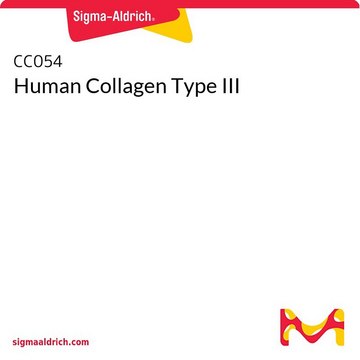C3511
Collagen from calf skin
Bornstein and Traub Type I (Sigma Type III), solid
About This Item
Productos recomendados
origen biológico
bovine (calf) skin
formulario
solid
técnicas
cell culture | mammalian: suitable
solubilidad
aqueous acid: soluble
idoneidad
suitable for substrate for collagenase
Nº de acceso UniProt
temp. de almacenamiento
2-8°C
Información sobre el gen
bovine ... COL1A1(282187)
¿Está buscando productos similares? Visita Guía de comparación de productos
Aplicación
Acciones bioquímicas o fisiológicas
Componentes
Nota de preparación
Otras notas
Código de clase de almacenamiento
11 - Combustible Solids
Clase de riesgo para el agua (WGK)
WGK 1
Punto de inflamabilidad (°F)
Not applicable
Punto de inflamabilidad (°C)
Not applicable
Equipo de protección personal
Eyeshields, Gloves, type N95 (US)
Certificados de análisis (COA)
Busque Certificados de análisis (COA) introduciendo el número de lote del producto. Los números de lote se encuentran en la etiqueta del producto después de las palabras «Lot» o «Batch»
¿Ya tiene este producto?
Encuentre la documentación para los productos que ha comprado recientemente en la Biblioteca de documentos.
Los clientes también vieron
Nuestro equipo de científicos tiene experiencia en todas las áreas de investigación: Ciencias de la vida, Ciencia de los materiales, Síntesis química, Cromatografía, Analítica y muchas otras.
Póngase en contacto con el Servicio técnico
